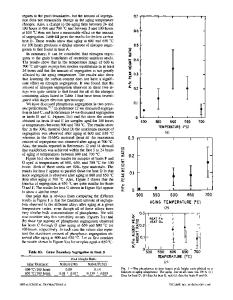Grain refinement of wrought austenitic stainless steels by rapid heating
- PDF / 1,388,536 Bytes
- 5 Pages / 613 x 788.28 pts Page_size
- 25 Downloads / 418 Views
where D is grain dtam, D Ois the initial grain dlam, t is time at t e m p e r a t u r e T, and K and Q a r e constants. Using Eq. [1] and the e x p e r i m e n t a l grain growth data of Stanley and P e r r o t a , 5 it can be e s t i m a t e d for type 316 s t a i n l e s s s t e e l that the time r e q u i r e d for the grain size to double from an initial d i a m e t e r of 10 ~m at 1050~ is of the o r d e r of 3 to 4 min. The doubling time at an initial grain size of 2 ~m is only about 8 s. Thus J. A. SCOTT and J. E. SPRUIELL are Graduate Assistant and Professor, respectively, Department of Chemical and Metallurgical Engineering, University of Tennessee, Knoxville, Tenn. 37916. Manuscript submitted February 9, 1973. METALLURGICAL TRANSACT[ONS
the minimum grain s i z e s that can be achieved by the usual heat t r e a t m e n t s c a r r i e d otit in furnaces is of the o r d e r of 15 to 20 ~tm. In o r d e r to significantly improve upon this value the time at t e m p e r a t u r e must be no m o r e than a few s e c onds and, in addition, the nucleation r a t e s during r e c r y s t a l l i z a t i o n must be sufficient to provide the d e s i r e d number of s t r a i n f r e e g r a i n s at impingement. These c o n s i d e r a t i o n s led us to investigate v e r y r a p i d heating following cold reduction as a grain refinement technique for austenitic s t a i n l e s s s t e e l s . Rapid heating techniques have been used by Speich and F i s h e r e to study r e c r y s t a l l i z a t i o n kinetics in a 3 8 8 silicon steel. Although they do not c o n s i d e r the p o s s i b i l i t y of using the techniques for grain refinement, they p r e s e n t an excellent review of available r a p i d heating methods. Austenite grain refinement techniques for s t e e l s that undergo decomposition to f e r r t t e - p e a r l i t e m i x t u r e s or to m a r tensite have been studied by Grange. 7 I. MATERIALS AND PROCEDURES Two austenitic s t a i n l e s s s t e e l s were used in this investigation. Most of the work was done on a heat of type 316 with the composition: 0.06 C, 17.30 Cr, 13.30 Nt, 2.33 Mo, 1.72 Mn, 0.40 Si, balance Fe. Some i n v e s tigation was a l s o done on a heat of type 304 with the composition: 0.04 C, 18.98 Cr, 9.04 Ni, 0.10 Mo, 1.51 Mn, 0.69 Si, balance Fe. Rapid heating was c a r r i e d out under controlled conditions by p a s s i n g e l e c t r i c c u r r e n t through the s t a i n l e s s s t e e l s a m p l e s in a c o m m e r c i a l , high speed, t i m e t e m p e r a t u r e control a p p a r a t u s commonly known as a GLEEBLE. This a p p a r a t u s is designed t ~ provide p r o g r a m m a b l e t h e r m a l c y c l e s and is e s p e c i a l l y well suited to e x p e r i m e n t s of the type r e p o r t e d here. This mode of r a p i d l y heating will be r e f e r r e d to as pulse heating. Samples were reduced by r o l l i n g to i n t e r m e d i a t e t h i c k n e s s e s such that further reductions of 25, 50, or 75 pct would r e s u l t in all s a m p l e s h
Data Loading...











